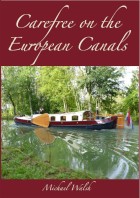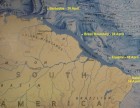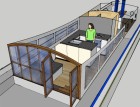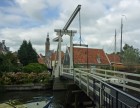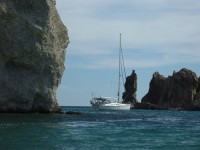Sequitur
Michael & Edi have headed out on a slow, thorough exploration of the globe.
| Vessel Name: | Sequitur and Zonder Zorg |
| Vessel Make/Model: | 2007 Hunter 49 and 1908 Wildschut Skûtsje |
| Hailing Port: | Vancouver, Canada |
| Crew: | Michael Walsh & Edi Gelin |
| About: | For our current location click, on Map & Tracking, then on the Google Earth logo. |
| Extra: | Follow us on Twitter: Follow @YachtSequitur |
| Social: |
13 January 2014
Another New Book Released
I am delighted to announce that my new book: Carefree on the European Canals is now in print and is available on Amazon.com, Amazon.ca [...]
26 April 2013
New Book Released
The proof copy of my new book arrived by courier today. I have approved it and it is now listed on Amazon for pre-order, with a publication date of 30 April. It is a rather large book at 680 pages in an 8.5 by 11 inch format with 315,000 words illustrated by over 2400 colour photos, charts and maps. [...]
24 April 2013
One Year Out of Brazil
One year ago today we sailed Sequitur out of Brazil after enduring more than six weeks in the least-friendly country that we had experienced during our three-year voyage. In the early evening of 24 April 2012 we crossed the line on the chart dividing Brazil from French Guyana and breathed a huge sigh [...]
27 October 2012 | Harlingen, Friesland
Planing a Metamorphosis
We have added a new post to the Zonder Zorg blog at: Planing a Metamorphosis.
29 September 2012 | Sneek, Netherlands
Onward to Friesland
We have arrived in Friesland and have added a new post to the skûtsje's blog at: Onward to Friesland
19 September 2012 | Hoorn, Netherlands
North From Aalsmeer
We have moved northward from Aalsmeer and I have added two new posts: Heading North From Aalsmeer and North From Amsterdam
13 September 2012 | Aalsmeer, Netherlands
Taking Possession
We are back in the Netherlands, and I have added some new posts to the ZonderZorg blog at: Taking Possession and Settling-In and Making Plans
20 August 2012 | Sequitur: St Augustine, USA - Michael & Edi: Vancouver, Canada - Nieuwe Zorg: Aalsmeer, Netherlands
Added a New Website
We have added a new website: Skûtsje ZonderZorg. Zonder zorg in Dutch means without worry. Our intention with the site is to provide a place to share some of the history, geography and culture of the skûtsje as we discover it. We will also use this place to document [...]
11 August 2012 | Sequitur: St Augustine, USA - Michael & Edi: Vancouver, Canada - Nieuwe Zorg: Aalsmeer, Netherlands
Still More Skûtsje History
We continued to attempt to track-down Douwe Albert Visser, who was the owner of Nieuwe Zorg in 1941 when she was re-registered. One of the problems we repeatedly encountered in our online searches was the effect of currently having Albert Visser and two Douwe Vissers as very competitive skûtsje racers, [...]
10 August 2012 | Sequitur: St Augustine, USA - Michael & Edi: Vancouver, Canada - Nieuwe Zorg: Aalsmeer, Netherlands
Some More Skûtsje History
While I was researching the history of Nieuwe Zorg, I finally found her first registration details obscured by an apparent typographical error in a transcribed online spreadsheet. She was listed as having been built in 1901 instead of 1908. I emailed the webmaster of the [...]
To Santa Rosalia
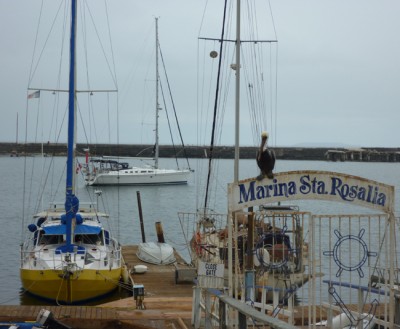

We motored at 2250 rpm, making water, doing another load of laundry and topping off the batteries. I did my weekly routine check of the electrolyte levels in the twelve cells of the two starter batteries and the thirty cells of the ten batteries that make-up our 1225 amp-hour house bank. When I had the house bank installed, I had purchased Water Misers to use as cell caps, and these have proved to be a very wise choice. They certainly slow the consumption of water; in the more than two-and-a-half years since I installed them, I have used just over five litres of distilled water to service the house bank and the two starter batteries. This week I needed to add a small squirt into only two of the forty-two cells, the first I've had to add in three weeks.
When we left the mouth of Bahia Concepcion, I opted for the slightly longer passage around the Islas Santa Ines, rather than transiting the pass between them and Punta Chivato. While the Mexican charts show no hazards in the nearly three mile wide passage, both the Guidebook and Sailing Directions indicate that 'passages should not be attempted without local knowledge'. Similarly, we opted prudently to take the slightly longer passage around Isla San Marcos, rather than heading through Craig Channel.

At 1535 we came to 15 metres on the Rocna in 5 metres of water in the harbour of Santa Rosalia. Our swinging circle took Sequitur's stern within 40 metres of the end of panga pier to our south and sterns of the boats alongside the floats in Marina Santa Rosalia to our west. The port here is an artificial harbour framed-in by a 500 metre breakwater on the east and a 320 metre breakwater on the south. The port, like much else here, is a remnant of the area's past as a company town for a French copper mining enterprise.

A century and a half ago, copper was discovered in the hills around Santa Rosalia, claims were staked and mining began. In 1885 a French company, Compagnie du Boleo, purchased many of the claims and began mining and smelting copper on a grand scale. Much of the timber for the plant's construction was brought in from British Columbia, and heavy machinery came from Europe. By the turn of the century, over 100,000 tonnes of copper had been produced. The breakwaters of the port were completed in the early 1920s using blocks of mining slag.

The French turned-over the mines and the facilities to a Mexican company in the mid-1950s and shortly thereafter, the mines began running out of copper. With no more ore, the smelting plant was officially closed in 1986. The vast complex of the plant runs for a quarter mile or more along the shores next to the harbour and its buildings extend up into the hills inland. The buildings and machinery lie unused and in varying stages of decay.

We relaxed onboard for the rest of the afternoon, and in the evening we enjoyed a nice dinner of prawns sauteed in butter with garlic, served on a bed of basmati rice and a butter-sweated julienne of carrot, poblano, green pepper, zucchini and white onion, garnished by sliced Roma tomato in basil. The
It is now over fifty years since the French pulled-out, and their influence is all but gone. There is a large old bakery, which sells bread it claims to be baguettes; however, our purchase for Wednesday's lunch had us thinking that the French recipes had been translated too many times over the past half century.

The architecture has a French colonial look, and there is one church that is decidedly French. According to the bronze plaque on its front, the church was designed in 1884 by Gustave Eiffel, constructed in 1887 and displayed at the Paris Exposition of 1889 next to the Eiffel Tower. It was later disassembled and stored in Brussels until it was shipped to Santa Rosalia, where it was re-erected between 1895 and 1897.

The old town sits in a relatively flat-bottomed valley no more than two hundred metres wide, which runs inland between steep hills. The main shopping area is in the first dozen or so blocks along the three central streets of the six that run up the valley for somewhat less than a kilometre. We walked up and down the streets looking in the shops, satisfying our curiosity and searching for fresh produce. There are many small businesses here, some no more than a two-seat taqueria cobbled onto the front wall of a house.

We finally found a sidewalk stall selling nice quality fresh produce. It was little more than posts and beams held together by plastic tarps, and the produce was displayed still in its shipping cartons. We selected some avocadoes, oranges, bananas, poblanos, tomatillos, Roma tomatoes, and a nice big cauliflower for a total of 69 pesos.

We decided to walk back to Sequitur by way of the upper roads, to get views over the old ore processing facilities and the smelter. Half way along, it began to drizzle, signalling a system passage foretold by Tuesday evening's clouds. When we arrived back at the entrance gate to the Marina Santa Rosalia, whose floats we had used as our dinghy dock, there was a pelican standing guard. After a convivial chat and some posing for photos, it dived on a fish in the water below.
We returned onboard for lunch and then relaxed in the coolness of the salon for the rest of the afternoon, listening to the strangeness of rain on the decks. With only a few hours of rain on Sequitur's decks since mid-October, we had almost forgotten the sound.

On Wednesday evening we dined on basa filets pan-fried in butter and garlic accompanied by steamed cauliflower and poblano and sauteed russet potato coins, all of which went wonderfully with the 2008 LA Cetto Chardonnay.

